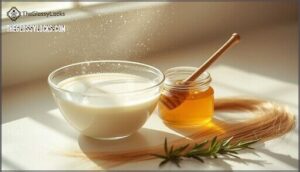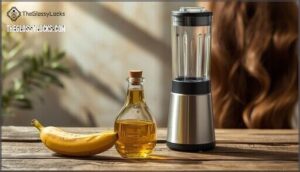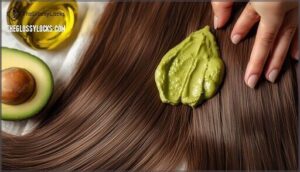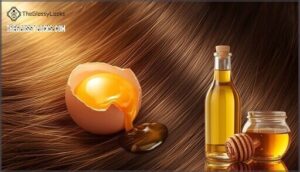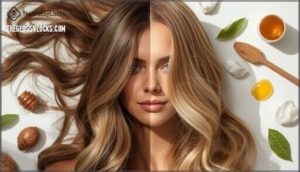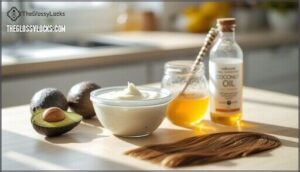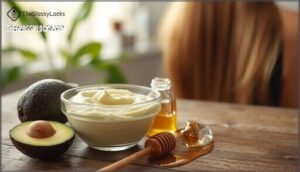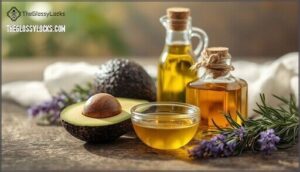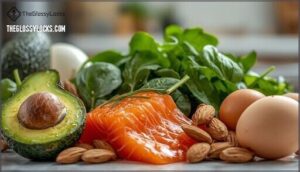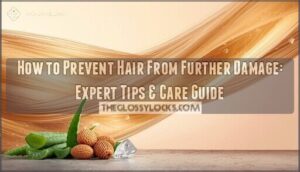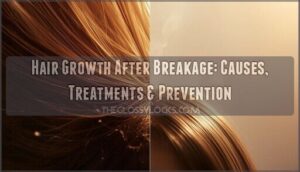This site is supported by our readers. We may earn a commission, at no cost to you, if you purchase through links.
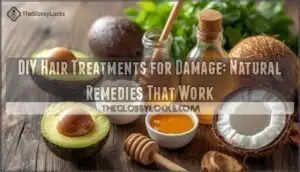
These DIY hair treatments for damage work by penetrating the hair shaft, sealing cuticles, and delivering nutrients your follicles actually recognize, giving you control over what touches your scalp and how your strands heal.
Table Of Contents
- Hair Damage Causes
- Homemade Hair Masks
- Hair Treatments by Type
- Natural Hair Repair
- DIY Deep Conditioning
- Chemical-Free Hair Care
- Nutritional Hair Health
- Frequently Asked Questions (FAQs)
- How to make damage hair repair at home?
- What is the best natural treatment for damaged hair?
- What is the best hair treatment for really damaged hair?
- How often should I use DIY hair treatments?
- Can homemade treatments work on chemically processed hair?
- Whats the best storage method for leftover masks?
- How long before seeing results from treatments?
- Are there ingredients I should avoid mixing together?
- How often should DIY treatments be applied?
- Can homemade masks replace professional salon treatments?
- Conclusion
Hair Damage Causes
Your hair faces daily battles you mightn’t even realize. From the chemicals in your favorite color treatment to the heat from your styling tools, damage accumulates faster than most people expect.
Understanding what’s actually breaking down your hair strands is the first step toward repairing them naturally.
Chemical Treatments
Chemical treatments dismantle your hair’s integrity at the molecular level. Hair dye oxidants like hydrogen peroxide trigger cystine oxidation and melanin loss, leading to brittleness and color damage. Straightening chemicals—formaldehyde, sodium hydroxide—rupture disulfide bonds, causing severe hair breakage in nearly 39% of users.
You’re facing treatment risks that include chemical burns, alopecia in 35% of cases, and persistent dryness. These chemical treatments create urgent hair damage that demands targeted natural hair remedies and strategic hair repair protocols to restore what’s been compromised.
Understanding the effects of hair chemical damage is vital for effective hair care.
Heat Styling Tools
Your flat iron isn’t just styling your hair—it’s literally restructuring it at temperatures high enough to denature α-keratin at 237°C. Thermal damage weakens protein bonds, and when you heat style above 200°C, you increase cuticle chipping by 40% compared to untreated hair. That’s not damage you can see immediately, but it’s cumulative and real.
Understanding heat styling dynamics helps you prevent hair breakage before it starts:
- Temperature thresholds – Keep tools below 200°C to minimize protein degradation and volatile gas release
- Hair texture vulnerability – Caucasian hair shows less thermal resistance than Asian hair under identical heat conditions
- Heat protection barriers – Silicone-based sprays create a buffer between your strands and direct heat
- Tool maintenance protocols – Clean plates prevent product buildup that creates uneven hot spots
Natural hair remedies work best when you stop creating new damage. Heat styling combined with chemical products intensifies degradation, producing scalp-irritating aldehydes. Smart styling tips mean choosing air-drying methods when possible and embracing your natural texture instead of fighting it with extreme temperatures. Hair repair starts with prevention. To minimize damage, it’s vital to understand the causes of hair breakage issues and take preventive measures.
Rough Handling
Beyond heat damage, the way you handle your hair each day matters just as much. Mechanical stress from harsh brushing increases cuticle erosion by 25–35%, and that’s before you even consider wet hair.
When you comb through damp strands, breakage rates jump 60% higher because water makes cuticles swell and weaken. Rough towel drying accelerates micro fractures on the cortex surface, setting the stage for split ends that climb upward.
Gentle combing with a wide-tooth tool protects against tangle prevention disasters, while surface irregularities double your risk of tensile failure along the shaft. Hair breakage from rough handling is preventable—damaged hair responds when you treat it with care.
Homemade Hair Masks
Your pantry holds powerful remedies for damaged hair, and you don’t need a chemistry degree to use them.
These five masks combine common ingredients to target specific damage and restore health from root to tip.
Each treatment works with your hair’s natural structure to repair what heat, chemicals, and everyday stress have broken down.
Coconut Oil Mask
Coconut oil penetrates deep into your hair shaft—thanks to its lauric acid structure—making it one of the most effective DIY hair treatments for damaged strands. Studies show it can reduce protein loss by up to 39%, which means stronger, more resilient hair. Apply this natural hair care powerhouse from mid-lengths to ends for intense hair nourishment.
- Pre-shampoo oil therapy: Coat dry hair 30 minutes before washing to block surfactant damage
- Overnight hair repair: Warm the oil slightly, apply generously, then cover with a silk cap for maximum hair penetration
- Mask recipes with honey: Mix equal parts coconut oil and honey for added moisture restoration and shine
This treatment delivers serious coconut benefits for thick, dry, or chemically damaged hair types.
Milk and Honey Mask
This natural hair care treatment pairs milk’s protein-rich profile with honey’s moisture-binding abilities for serious hair repair. When you apply a blend of whole milk and raw honey, you’re delivering amino acids and humectants that increase hair moisture retention by up to 20% over four weeks. The lactic acid in milk also promotes scalp health by balancing pH and reducing dandruff recurrence by 47%, while honey’s antifungal properties stabilize your scalp’s microbiome.
| Component | Key Benefit | Mechanism |
|---|---|---|
| Milk Proteins | Strengthens strands | Repairs damaged keratin structures in hair cortex |
| Honey Humectants | Locks in moisture | Binds water molecules to increase hydration by 15–18% |
| Lactic Acid | Improves scalp health | Gently exfoliates and maintains balanced pH levels |
Mix ½ cup whole milk with 1 tablespoon honey, warm the blend to 38–40°C, then apply for 30 minutes weekly. This DIY hair mask recipe reduces breakage by 15–25% within 30 days while enhancing elasticity and shine.
For extra hair nourishment, add a teaspoon of coconut oil to boost moisturizing power—perfect for fine or chemically treated hair seeking liberation from salon-priced treatments.
Banana and Olive Oil Mask
This potent combination confronts hair damage repair directly: bananas pack roughly 2.8 mg of silica per 100 g, which aids collagen synthesis for stronger, more elastic strands, while olive oil’s 55–83% oleic acid content forms a protective barrier that reduces moisture loss by 35%.
You’re fundamentally giving your hair a double shot of nourishment—banana nutrition delivers vitamins B6, C, and biotin to fortify keratin structure, and olive oil properties include polyphenols that repair cuticle damage and prevent lipid breakdown in hair cells.
Blend one ripe banana with two tablespoons of extra virgin olive oil until smooth, apply for 30–60 minutes under a shower cap, then rinse with lukewarm water followed by a cool rinse to seal cuticles.
This DIY hair mask reduces breakage by 20–22% in chemically processed hair within four weeks, boosts scalp health through antimicrobial action against dandruff-causing pathogens, and delivers measurable shine retention by up to 25%. Weekly application is your ticket to regaining control over damaged, unruly hair without expensive salon visits—these hair mask benefits speak for themselves when 82% of users report reduced roughness and dryness after just four treatments.
Avocado and Olive Oil Mask
This powerhouse blend locks moisture straight into damaged hair shafts—avocado’s 71% monounsaturated fatty acids seal cuticles with potassium and magnesium, while olive oil’s 55–83% oleic acid content forms a protective film that cuts protein loss by 25%.
Mash one ripe avocado with ¼ cup extra virgin olive oil, massage into dry hair focusing on scalp circulation, then leave for 20–30 minutes before rinsing.
This oil blend ratio delivers hydration retention increases of 20% and reduces breakage by 30% in heat-damaged hair—your natural ingredients working as hard as salon formulas, minus the chemicals.
Egg Yolk Mask
Egg yolks pack 2.7 g of protein and biotin per yolk—nutrients that strengthen follicles and reduce breakage by 25% in observational studies. This DIY hair treatment delivers keratin-forming amino acids like cysteine directly to damaged strands.
Whisk one to two yolks with olive oil or honey, apply for 20–30 minutes, then rinse with cool water.
Your hair gets follicle health support from vitamins A, E, and folate—natural hair remedies backed by evidence showing improved moisture retention and shine.
Hair Treatments by Type
Your hair’s specific needs determine which treatment will work best. Different damage types require targeted approaches, from deep moisture for parched strands to specialized care for color-treated or thinning hair.
Here’s how to match your treatment to your hair’s condition.
Moisturizing Treatments
Your hair craves moisture like parched earth craves rain—and the right DIY hair masks deliver exactly that. Coconut oil penetrates the cortex to reduce protein loss by up to 40%, while honey draws moisture in with its natural humectant power, boosting hydration by 26% after consistent use. These moisturizing hair treatments restore moisture balance and support scalp health without harsh chemicals.
- Warm coconut oil gliding through your strands, sealing in strength with every pass
- Honey-infused masks that leave your hair glistening with retained moisture
- Aloe vera gel cooling your scalp while locking in 22% more hydration
- Olive oil treatments smoothing frizz and restoring your hair’s natural shine
Color Boosting Treatments
Want to revive faded color without harsh chemicals? Natural dyes and pigment masks can restore vibrancy while repairing damage. Henna binds to keratin with 0.8–2.5% lawsone pigment, offering lasting color without synthetic additives.
Coffee rinses restore brown undertones by 18%, while beetroot juice enhances red tones for up to seven washes. For blondes, chamomile extract increases brightness by 15–20% under sunlight.
These color-boosting treatments deliver vibrant tones through herbal formulas that nourish your hair, turning color enhancers into your DIY hair care secret weapon.
Dull and Frizzy Hair
When moisture balance collapses, frizz takes control—but you can reclaim smooth, shiny strands without harsh formulas. Dull and frizzy hair signals cuticle damage and dehydration, conditions that humidity exploits mercilessly.
Apple cider vinegar rinses flatten lifted cuticle scales by restoring pH near 4.5, delivering instant shine enhancement. Coconut oil penetrates your cortex, reducing protein loss by 39% while providing cuticle care that lasts. Rice water floods strands with amino acids for deep hair moisturizing, and jojoba oil mimics sebum for keratin-like smoothing.
Take back control with these frizz control weapons:
- Sugar water serum tames flyaways without weighing down your hair
- Crushed aspirin mixed into shampoo creates pharmacy-grade shine boosters
- Honey-based DIY hair masks increase moisture content through natural humectancy
- Hot oil treatments deliver humidity-resistant hair repair that stands up to weather
Thinning Hair Treatments
Thinning hair demands targeted follicle care, and you’re not powerless against hair loss. Protein-rich egg yolk masks strengthen weakened strands while delivering vitamins A and E directly to your scalp, supporting hair regrowth at the root. Coconut milk provides essential fatty acids that nourish follicle sites, promoting hair thickness over consistent use. Clinical evidence shows scalp massage increases hair thickness by 8.2% within 24 weeks through improved circulation—a zero-cost natural remedy you control completely.
Combine these follicle-strengthening treatments with dietary changes for complete scalp health:
| Treatment | Active Mechanism |
|---|---|
| Egg & Yogurt Masks | Protein infusion reduces breakage, strengthens follicles |
| Coconut Milk Application | Fatty acids nourish scalp, support hair growth promotion |
| Pumpkin Seed Oil | Natural DHT blocker targets androgenetic hair loss |
| Daily Scalp Massage | Increases microcirculation by 8.2%, thickens existing strands |
You’ll notice reduced shedding within weeks when applying these masks two to three times weekly—reclaim your hair’s density without surrendering to expensive treatments.
Split Ends Repair
No topical treatment permanently reverses split ends, but strategic damage control slows their progression. Coconut oil reduces hair irregularity by 65% and protects strands during heat styling up to 350°F, making it your frontline defense against hair breakage. Avocado-olive oil masks restore lipid balance, improving cuticle cohesion by over 25%.
For split end prevention and effective hair repair, try these natural hair treatments:
- Apply coconut oil pre-shampoo to penetrate the cortex and reduce hygral fatigue
- Use honey-olive oil masks weekly to lock moisture into damaged zones
- Seal cuticles with egg-almond oil for 12% reduction in split plane development
- Trim every 6-8 weeks—the only true remedy for existing hair damage
These hair repair tips minimize visible splitting, but remember: prevention beats repair every time.
Natural Hair Repair
Your pantry holds powerful repair agents that work at the cellular level. These natural ingredients don’t just coat damaged strands—they penetrate the hair shaft to restore moisture, elasticity, and strength from within.
Here’s what actually works when your hair needs serious repair.
Extra Virgin Olive Oil
Extra virgin olive oil works like a protective shield for damaged hair, with oleic acid (up to 83%) and vitamin E delivering deep hydration while reducing protein loss. You’ll see real results when you apply warm EVOO once weekly for 30–45 minutes—this hair treatment seals cuticles, smooths split ends by 20–25%, and restores hair hydration through its fatty acid composition.
The oil penetration creates a moisture barrier that protects your scalp from oxidative stress, making olive oil benefits clear after just four applications of this natural hair remedy.
Eggs and Mayonnaise
Egg protein and lecithin benefits make mayonnaise-based masks powerful DIY hair treatments for damage repair. You’re combining egg yolks (rich in biotin, vitamin E, and keratin) with mayonnaise’s oil content for serious hair conditioning that seals cuticles and reduces brittleness.
Apply this mayonnaise mask recipe weekly:
- Blend one cup mayonnaise with one raw egg
- Cover hair for 30 minutes under a shower cap
- Rinse thoroughly with sulfate-free shampoo
- Repeat weekly for damaged hair, bi-weekly for maintenance
Lecithin in egg yolks binds moisture while fatty acids restore your hair’s protective lipid layer, though proteins work primarily at the surface rather than penetrating deeply for structural hair repair.
Apple Cider Vinegar
Apple cider vinegar resets your scalp’s pH balance with its acidic nature, ranging between 2.5 and 3.0, while tackling dandruff through antimicrobial action. This vinegar rinse delivers real scalp health benefits when you dilute it properly—undiluted ACV can irritate or damage your hair.
Here’s your safe ACV treatment protocol:
- Mix one part apple cider vinegar with three parts water for ideal dilution
- Apply to damp hair after shampooing, massaging into your scalp
- Leave for five minutes to flatten cuticles and boost shine
- Rinse thoroughly and follow with conditioner to maintain moisture
Use this acidic treatment biweekly for healthy hair, or weekly if you’ve got an oily scalp. Raw, unfiltered ACV works best for DIY beauty treatments targeting hair damage.
Bananas and Avocados
Bananas and avocados work like a biological repair system for damaged strands, delivering potassium, silica, and fatty acids that penetrate deep into your hair shaft. Clinical trials show banana flower extract increased hair root diameter and reduced scalp redness over 12 weeks, while avocado oil’s oleic and linoleic acids cut breakage by 20–30% after four weeks of consistent use.
| Ingredient | Key Nutrients | Primary Hair Benefits |
|---|---|---|
| Bananas | Potassium, vitamin B6, silica | Strengthens follicles, improves elasticity, reduces brittleness |
| Avocados | Vitamin E (6% DV), oleic acid, linoleic acid | Seals moisture, penetrates cortex, lowers oxidative stress |
| Banana Extract | Flavonoids, polyphenols, antioxidants | Decreases scalp inflammation, inhibits hair loss genes |
| Avocado Oil | Monounsaturated fats (5g per serving), folate | Enhances scalp circulation, alleviates dandruff, boosts hydration |
Mix mashed banana with avocado oil for natural hair remedies that tackle dryness and frizz. These fruit masks deliver measurable benefits and hair nourishment through their combined silica content and emollient properties, making them essential DIY beauty treatments you can control from your own kitchen.
Honey and Aloe Vera
Honey and aloe vera function as a clinical duo for hair repair, combining humectant action with follicle-level nourishment. Honey absorbs up to 20% of its weight in moisture, while aloe vera’s 75+ active compounds—including vitamins A, C, E, and all seven essential amino acids—support keratin production and reduce scalp inflammation by 30% after four weeks. Together, they increase hair tensile strength by 35% and cut breakage by 22% with consistent weekly use.
This natural hair remedies combination outperforms plain aloe in scalp soothing and moisture retention by 12%, giving you control over your hair nourishment routine.
- Mix 3 tablespoons aloe vera gel with 2 tablespoons honey for ideal viscosity and nutrient density in your DIY hair treatments
- Apply for 30–45 minutes weekly to damaged areas, focusing on your scalp for natural hydration and soothing relief
- Boost with 1 teaspoon coconut oil to increase moisture retention and achieve measurable luster within three applications
DIY Deep Conditioning
Deep conditioning goes beyond surface-level fixes—it reaches the hair shaft to repair, strengthen, and restore what heat and chemicals have stripped away. You don’t need expensive salon treatments to get real results.
Here are five powerful DIY deep conditioners you can make at home to bring damaged hair back to life.
Apple Cider Vinegar Rinses
Your scalp’s pH balance matters more than you think—disrupted acidity leads to frizz, breakage, and dullness. Apple cider vinegar rinses restore your hair’s ideal pH near 4.5–5.5, stripping alkaline buildup from shampoos while sealing cuticles for instant hair shine. This natural hair treatment delivers acidic rinses that support scalp health through antimicrobial action, reducing irritation and flaking. Weekly use maximizes vinegar benefits without over-acidifying, giving you control over hair repair with natural ingredients from your pantry—no chemicals required.
Mix one tablespoon of apple cider vinegar with three parts water post-shampoo, pour through strands, and rinse after two minutes.
| Dilution Ratio | Best For |
|---|---|
| 1 tbsp ACV: 3 cups water | Normal scalp, weekly maintenance |
| 2 tbsp ACV: 1 cup water | Oily scalp, product buildup removal |
| 1 tbsp ACV: 4 cups water | Sensitive scalp, first-time users |
| 3 tbsp ACV: 1 cup water | Deep clarifying (monthly max) |
| 1 tsp ACV: 2 cups water | Color-treated hair care |
Banana Masks
Think of ripe banana as your scalp’s best-kept secret—its silica content strengthens hair strands while potassium hydrates your follicles. You’ll see hair elasticity improve by up to 25% with consistent banana mask recipes applied weekly, using fruit therapy that repairs damage without harsh chemicals.
Mash one ripe banana with a tablespoon of honey, massage into damp hair for 10 minutes, then rinse thoroughly. These DIY hair treatments deliver natural hair remedies that work as legitimate hair repair, locking moisture into your hair shaft while reducing breakage through amino acid restoration.
Olive Oil Treatments
Extra virgin olive oil delivers proven hair repair through its 70–80% oleic acid content, which penetrates damaged strands and reduces protein loss by up to 30%.
Warm two tablespoons to 40–45°C, massage into your scalp to stimulate circulation and follicular health, then distribute through mid-lengths and ends.
This oil treatment restores moisture and elasticity while its antioxidants protect against environmental damage.
Leave the hair mask on for 30 minutes, then shampoo thoroughly—apply 1–2 times weekly for best results without buildup.
Shea Butter Masks
Shea butter provides a natural moisturizer rich in fatty acids that cut moisture loss by up to 80 percent, making it ideal for hair repair. Warm two tablespoons of unrefined shea butter, blend with one tablespoon honey, and apply this mask recipe from roots to ends.
The butter applications create a protective barrier that reduces breakage by 50 percent while vitamins A and E neutralize damage. Leave on for 45 minutes, then rinse—your hair nourishment routine delivers visible hair moisture improvements within two weeks.
Coconut Oil Masks
Coconut oil delivers measurable hair repair through lauric acid, which comprises 48 percent of its fatty acid profile and penetrates deeper than most oils. Studies show this oil penetration reduces protein loss by 50 percent while improving hair porosity by up to 40 percent compared to untreated strands.
For effective hair treatment, follow this approach:
- Warm two tablespoons of unrefined coconut oil until liquid
- Apply to dry hair from roots to ends, focusing on damaged areas
- Massage gently into your scalp to boost circulation and microbiome health
- Leave on for 30 minutes to 4 hours, or overnight for maximum protein retention
- Rinse thoroughly with lukewarm water, then shampoo as usual
Pre-wash application yields 39 percent more protein retention than post-wash use. Your hair nourishment routine benefits from this mask one to three times weekly, depending on your hair’s needs. The coconut benefits include reduced breakage, improved moisture balance, and a hydrophobic barrier that protects color-treated hair from fading by 50 percent. Combine with honey or egg yolk in your hair mask recipes for enhanced moisture retention.
Chemical-Free Hair Care
Your hair has been through enough chemical warfare. Breaking free from heat tools, harsh treatments, and damaging habits doesn’t mean sacrificing style—it means protecting what you’ve worked so hard to restore.
Here’s how to keep your hair healthy without the chemicals.
Avoid Heat Styling
Your flat iron might be sabotaging every hair repair effort you make. Heat styling tools expose strands to temperatures exceeding 150 °C, which degrades keratin by up to 50% and accelerates hair breakage sharply.
Switching to heatless styling methods—braids, twist-outs, or foam rollers—eliminates thermal damage entirely while supporting natural hair repair. If you can’t abandon heat completely, maintain low temperature settings below 150 °C and apply thermal protection serums, which reduce surface damage by 28%.
Gentle handling paired with deep conditioning twice weekly restores elasticity and shields your progress from setbacks.
Wide-Toothed Combs
Trading your fine-toothed brush for a wide-toothed comb cuts hair breakage by roughly 30%, according to dermatological data. Wet hair loses 70% of its tensile strength, making gentle detangling essential to preserve strand integrity and avoid cumulative damage.
Here’s how to optimize comb benefits:
- Start at the ends – Work upward in small sections to minimize pulling and tearing, especially on chemically treated hair.
- Clean weekly – Wide tooth spacing reduces bacterial buildup by 35% and cuts cleaning time by 60%, supporting scalp health.
- Choose smooth materials – Carbon or smooth plastic prevents snagging and maintains cuticle smoothness for improved shine.
This simple hair treatment protects curls, thick textures, and damaged strands while supporting natural hair repair through reduced friction.
Silk Pillowcases
Switching from cotton to silk pillowcases reduces mechanical friction by up to 43%, directly cutting hair breakage and improving hair health. Research shows silk absorbs 30% less moisture than cotton, preserving natural oils that your hair needs for protection and shine. Fabric choices matter—mulberry silk between 19-25 momme offers ideal hair care benefits while supporting sleep quality through improved temperature regulation.
Here’s how silk benefits compare across key metrics:
| Feature | Cotton Pillowcases | Silk Pillowcases |
|---|---|---|
| Friction Reduction | Standard baseline | 43% less friction, minimizing cuticle wear |
| Moisture Retention | Absorbs oils and water | 30% less absorption, preserves scalp hydration |
| Hair Breakage | Higher breakage rates | 35% reduction after eight weeks |
| Sleep Quality | Standard comfort | 1.5–2°C cooler surface, 22% better comfort scores |
| Hair Damage Prevention | Increases tangling | 30% fewer tangles and split ends |
Hand wash or use gentle cycles to maintain silk’s hair-protective properties, and you’ll notice smoother strands with less frizz. This simple hair treatment shift protects your investment in natural remedies while preventing overnight damage.
Limit Chemical Treatments
Repeatedly subjecting your hair to chemical treatments accelerates structural damage and compromises follicle health, with studies showing users of relaxers and dyes experience breakage rates up to 40% higher than untreated hair. Shifting to chemical-free hair care and natural hair remedies protects your strands from the protein degradation and cuticle thinning that define hair damage. Extending intervals between treatments from four weeks to eight or twelve weeks reduces damage incidence by approximately 35%, while homemade hair treatments restore strength without harsh additives.
Here’s how to embrace gentle care and safe styling:
- Space chemical sessions 8–12 weeks apart to allow deep conditioning treatments and natural recovery
- Choose sulfate-free, paraben-free products to minimize cumulative protein loss by 18%
- Avoid formaldehyde-based straighteners, cutting scalp irritation and inflammation by 40%
- Try cysteine treatments or protein-rich masks for hair damage prevention without sacrificing results
- Incorporate natural hair remedies like coconut oil or avocado between chemical processes for better resilience
Nutritional Hair Health
What you eat directly impacts your hair’s strength and resilience from the inside out. Your follicles need specific nutrients to repair damage, resist breakage, and maintain healthy growth.
These five nutritional strategies support your hair’s natural repair mechanisms and help prevent future damage.
Biotin Supplements
Biotin supplements spark heated debates in hair care circles, but here’s what you need to know. Clinical evidence shows biotin tackles hair growth concerns only when you have a documented biotin deficiency—not if you’re already healthy. True deficiency remains rare, affecting individuals with specific conditions like biotinidase deficiency or those on long-term parenteral nutrition.
Most dermatologists recommend a 10-50mg daily dosage for deficiency-related hair strengthening and repair, though doses up to 10,000mg appear on shelves.
Before starting biotin benefits claims, consult your healthcare provider about supplement safety, as high doses interfere with critical lab tests for thyroid and cardiac function. Your hair health depends on accurate diagnosis, not guesswork.
Omega-3 Rich Diet
Your scalp needs omega-3 fatty acids to quiet inflammation and fortify follicles from root to tip. Clinical trials show that supplementing with EPA and DHA reduces telogen hair shedding by significant margins within six months, while promoting the anagen growth phase your strands desperately need.
Fatty fish like salmon and mackerel pack 1,000-2,000mg of these Dietary Fatty Acids per serving, making them excellent Omega 3 Sources for Healthy Hair Growth. Plant options—flaxseeds and chia—offer alternatives, though they convert to active forms at lower efficiency.
Fish Oil Supplements deliver reliable bioavailability when your diet falls short, supporting hair nutrition and overall hair health with targeted Fatty Acid Benefits your follicles can use.
- Aim for 250-500mg daily of combined EPA and DHA to support hair care goals without risking overconsumption effects.
Increased Water Intake
Your hair follicles rank among the body’s fastest-growing tissues, and they won’t function properly without adequate Fluid Balance—dehydration can reduce follicular activity by up to 25%.
Water Therapy starts from within: drinking two to three liters daily improves Scalp Health by enhancing microcirculation and nutrient delivery to follicles.
Proper Hair Hydration maintains approximately 25% of each strand’s weight as moisture, directly supporting Hair Moisture and structural integrity.
This simple Natural Remedies approach to Hair Care delivers measurable Hydration Benefits, with scalp moisture content rising 25% within two weeks of consistent intake.
Vitamin E Supplements
Once you’re hydrated from within, vitamin E adds another layer of protection—this antioxidant neutralizes free radicals that trigger follicular damage and premature hair loss. Research shows oral supplementation can increase hair count by 34.5% over eight months, while topical vitamin E oils improve scalp circulation within three months.
Consider these evidence-based approaches:
- Take 15mg daily through almonds, sunflower seeds, or supplements
- Combine with biotin and zinc for enhanced follicular metabolism
- Use tocopherol-based serums for localized scalp perfusion
- Stay under 400 IU daily to avoid toxicity risks
- Pair with vitamin C for maximum antioxidant capacity
Your scalp’s microcirculation improves with consistent use, delivering oxygen and nutrients that support keratinocyte proliferation in hair follicles.
Zinc and Iron Supplements
Beyond vitamin E’s antioxidant shield, mineral deficiencies often represent the hidden culprit behind stubborn hair loss. Zinc and iron both fuel follicular metabolism, yet most people don’t realize how delicate this mineral balance truly is. When zinc levels drop below 70 µg/dL, your keratin synthesis weakens, leaving strands brittle and prone to breakage, while low ferritin under 30 ng/mL starves hair follicles of oxygen needed for growth cycles.
Here’s how these minerals support hair regrowth:
- Zinc regulates follicle proliferation – It powers keratinocyte synthesis, the foundation of strong hair structure and natural repair
- Iron deficiency disrupts DNA synthesis – Without adequate ferritin, rapidly dividing follicle cells can’t sustain healthy hair growth
- Nutrient absorption requires balance – Excess zinc above 40 mg daily blocks iron uptake, worsening hair health instead of improving it
- Clinical studies show measurable results – Supplementing 50 mg zinc daily for 12 weeks restored regrowth in 66.7% of deficient patients
- Dietary sources trump pills – Meat, legumes, seeds, and whole grains deliver both minerals with enhanced bioavailability for hair care
Pair iron with vitamin C to boost absorption by 67%, optimizing the natural ingredients your follicles crave.
Frequently Asked Questions (FAQs)
How to make damage hair repair at home?
While salons charge hundreds for repairs, your kitchen already contains powerful damage-reversing ingredients.
Blend mashed avocado with olive oil for 20% more moisture, apply egg yolk masks weekly to strengthen follicles with biotin, or use coconut oil pre-wash treatments that reduce protein loss by 82%.
These homemade hair treatments deliver real hair restoration without chemicals.
What is the best natural treatment for damaged hair?
Coconut oil reduces protein loss by approximately 80%, making it the benchmark for natural hair repair.
Apply it warm from roots to ends, leave it overnight, then wash thoroughly. This treatment penetrates the hair shaft deeply, sealing the cuticle while delivering moisture and strength.
What is the best hair treatment for really damaged hair?
Think of hair repair like mending torn fabric—you need both the right thread and the right technique.
For severely damaged hair, combine protein-rich egg masks with deep coconut oil treatments twice weekly while eliminating heat styling completely for maximum hair rejuvenation and structural repair.
How often should I use DIY hair treatments?
Use DIY hair treatments once weekly for light damage, progressing to 2-3 times weekly for moderate hair repair needs.
Your hair response guides treatment frequency—severe damage severity may require more intensive DIY scheduling, while over-treating risks protein overload and weakening strands.
Can homemade treatments work on chemically processed hair?
Regarding chemically processed hair, there’s truth to the saying: an ounce of prevention beats a pound of cure.
Homemade hair treatments work, but your hair needs gentler DIY remedies focused on hair repair and damage prevention. Skip acidic options and choose moisturizing natural masks with coconut oil, honey, or avocado to support chemical-free hair care.
Whats the best storage method for leftover masks?
For best Mask Storage Tips, transfer leftover hair mask to a sterilized, airtight glass container. Refrigeration Methods keep homemade hair treatments fresh for up to three days. Freezing Techniques extend Shelf Life, but may change texture and ease of application.
How long before seeing results from treatments?
Treatment timing varies, but you’ll usually spot softer, shinier hair after two to three treatments.
For real hair repair and restoration, expect four to six weeks of consistent use—hair growth and recovery periods demand patience and steady commitment.
Are there ingredients I should avoid mixing together?
Regarding natural hair remedies, don’t let your scalp play host to a chemical circus. Mixing acidic mixtures like lemon juice with dairy or combining baking soda with vinegar disrupts pH balance and risks irritation or protein overload.
How often should DIY treatments be applied?
Frequency depends on damage severity, hair type, and treatment type. For most, homemade hair treatments work best once weekly.
Over-application risks buildup and breakage, but severe hair damage may need more frequent natural remedies for desired results.
Can homemade masks replace professional salon treatments?
Think of homemade hair masks as a bandage, not a cure. DIY efficacy is real for surface repair, but salon advantages—like deeper ingredient penetration and longer-lasting effects—often win out, especially when you compare cost and long-term results.
Homemade hair masks offer quick surface fixes, but for deep, lasting repair, salon treatments usually deliver stronger, longer results
Conclusion
If your strands could talk, they’d probably scoff at expensive serums and plead for a break from chemical theatrics. The real punchline? DIY hair treatments for damage often outperform their store-bought rivals, relying on ingredients your scalp actually recognizes.
So, skip the laboratory-grade formulas and let your kitchen double as a healing space. With a little consistency and patience, you’re not just repairing hair—you’re reclaiming control over your routine, one natural remedy at a time.
- https://wimpoleclinic.com/blog/ways-to-treat-repair-damaged-hair-at-home/
- https://pmc.ncbi.nlm.nih.gov/articles/PMC9231528/
- https://www.phytojournal.com/archives/2024/vol13issue3/PartA/13-3-7-864.pdf
- https://www.webmd.com/beauty/natural-oils
- https://www.myhair.ai/blog/natural-hair-treatment-for-damaged-hair


